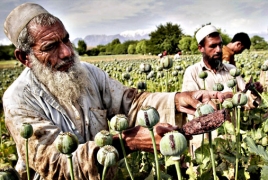
Afghanistan saw a 10 percent jump in opium cultivation this year because of bumper harvests, collapsing eradication efforts due to growing insecurity and declining international aid to combat drugs, the UN said Sunday, October 23, according to AFP.
Cultivation dropped last year due to drought but it has been on the rise in the past decade, fuelling the Taliban insurgency and spurring a growing crisis of drug addiction despite costly U.S.-led counter-narcotics programmes.
High levels of cultivation this year meant the estimated opium production soared 43 percent to 4,800 tons, a UN Office on Drugs and Crime (UNODC) report said, underscoring a "worrying reversal" in efforts to combat the scourge of drugs.
"The cultivation has increased by 10 percent this year compared to the same time in 2015 -- from 183,000 hectares to 201,000 hectares," counter-narcotics minister Salamat Azimi told reporters while releasing the UN report.
The statistics represent the third-highest level of cultivation in Afghanistan in more than two decades -- after a record high in 2014 and 2013.
Officials cited favourable weather, rising insecurity and falling international donor support as the main reasons for the increase in cultivation in Afghanistan, the world's leading producer of opium.
Ninety-three percent of the cultivation took place in the southern, western and eastern parts of the country, the report said.
The southern restive province of Helmand remained the country's top poppy-cultivating province, followed by Badghis, Kandahar, Uruzgan, Nangarhar and Farah -- all hotbeds of insurgent activity.
"I believe with the existing equipment, facilities and civilian task force, we cannot fight the cultivation of poppy in insecure areas," said Baz Mohammad Ahmadi, deputy minister of interior for counter-narcotics.
"The challenges of deteriorating security in different parts of the country took away the opportunities to destroy poppy farms."

